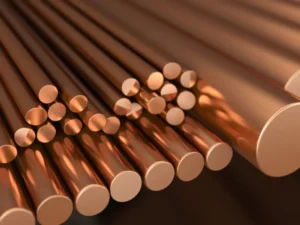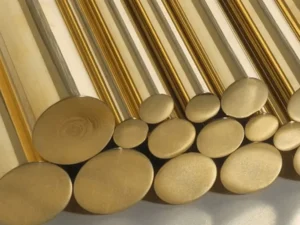The debate about brass vs bronze vs copper has been around for years. The apparent reason is that these metal titans make our lives possible in different ways. Life would be incomplete without any of those.
From households to industrial-level products, these metals play pivotal roles in maintaining lives. However, these three metals differ from each other in many ways. This guide will explore their differences and let you know their intricacies. So, let’s dive right in!
Overview of Brass, Bronze, And Copper
Copper is a pure, non-ferrous transition metal. However, brass and bronze are copper alloys. They are categorized as Red metals. Their properties are different from each other because of other alloys. For example, tin in bronze and zinc in brass.
Brass is a highly cost-effective alloy made from copper and zinc, making it an excellent choice compared to other metals. The presence of zinc makes brass very strong and malleable. On the opposite side, bronze is an alloy of copper with tin, the proportion of which is no more than 12%.
Notably, brass and bronze are more than just alloys or mixtures of two elements. They consist of traces of many other components as well. For example, bronze contains arsenic, phosphorus, aluminum, manganese, and silicon. However, copper and zinc are the primary components.
Copper itself is dominant in terms of usability, demand, and price. However, these three metals have existed on Earth for thousands of years. They have been used to manufacture different products since the time of the Greeks and Romans.
Differences Between Brass, Bronze, And Copper
All three metal triads have different physical and chemical properties. Based on those differences, they are used in various industries. In the section below, we will discuss the contrasts among them. But before we jump in, here is the table showing their distinctions.
| Property | Brass | Bronze | Copper |
| Composition | Copper + Zinc | Copper + Tin | Pure Copper |
| Color | Golden/Yellow | Earth-Brown | Reddish-Brown |
| Electrical Conductivity | Moderate | Moderate | High |
| Durability | Moderate | High | Moderate |
| Corrosion Resistance | Moderate | High | Moderate |
| Antimicrobial Properties | Not significant | Not significant | Yes (Antimicrobial) |
| Brinell Hardness | 55-73 | 40-420 | 33.3 (Soft) |
| Price and Affordability | Less expensive | Mid-range | Premium & Expensive |
1- Composition & Hardness
In the section above, I provided an overview of the composition of these three metals. However, the copper is pure. On the other hand, brass and bronze are alloys containing copper and many different elements in traces. Here is the composition of Brass and bronze.
| Alloy | Composition |
| Brass | Copper (Cu): 60-90%, Zinc (Zn): 10-40% |
| Bronze | Copper (Cu): 88-95%, Tin (Sn): 5-12%, |
Keep in mind that both brass and bronze contain some other elements that are present in traces. Due to their smaller amount, we generally count zinc and tin in the composition of brass and bronze, respectively.
Regarding hardness, bronze is at the top due to its vital alloy elements, such as tin, silicon, aluminum, manganese, and many others. On the other hand, brass is less rigid than bronze and more robust than copper.
Zinc (10 to 40%) in the brass makes it strong. If the brass has a lower portion of zinc, then it will be less rigid, and vice versa. Copper is very soft and does not contain any alloy. That’s why it is used to make wires and other electrical systems.
2- Durability & Corrosion
As I said earlier, bronze is rugged and robust, so there is no question about its durability and longevity. It can withstand the harshest outdoor conditions. The products made with bronze last for years. For example, statues and sculptures.
However, the brass is in the second position due to its mediocre strength. Copper, being soft, does not offer durability. Especially if the copper-made products are exposed to harsh conditions, they deteriorate.
As far as the corrosion resistance is concerned, both copper and bronze are excellent. The reason is that they make protective layers on their surface. These layers protect them from moisture and other conditions.
Brass is not rust-resistant and quickly loses its quality when left in moisture. Manufacturers usually apply a layer of paint to brass products. They do this to prevent rust and make them last longer.
3- Conductivity & Ease of Weldability
Copper outshines other metals when it comes to electrical conductivity. Its exceptional conductivity makes it the top choice for making wires and many electrical parts. These include motors, fans, and more.
Brass offers some resistance and only conducts electricity up to 28%, making it second. The bronze strongly resists electricity conductivity due to the presence of tins and other alloy elements. It only conducts electricity up to 15%.
Regarding weldability, copper (especially in its oxygen-free state) outclasses other metals. The reason is that it has high thermal conductivity and dissipates heat when heated during the welding process. It has good heat dissipation. This enables easy and strong welding. So, it’s a top choice for many welding jobs.
Brass comes second, and bronze comes last due to its tin and other alloys that produce cracks at the weld. Remember that all three metals can be welded using the proper strategy and suitable welding machines. However, their ease of welding varies, as I have mentioned above. Usually, TIG and MIG prove to be efficient in welding these metals.
4- Tensile Strength & Machinability
Yield strength is crucial in engineering work. It is defined as the ability of a material to withstand deformation under stress. Material with greater yield strength is accepted as safe and reliable and vice versa. Here is the comparison of the yield strength of these metals:
| Alloy | Yield Strength (MPa) |
| Copper | 33.3 MPa |
| Brass | 95-124 MPa |
| Bronze | 125-800 MPa |
Metalworking depends heavily on advanced techniques such as 3D printing and CNC machining. So, if the metal metal is not machineable, it is considered unfavorable for many industries. It is all about how good a material is for cutting and shaping or when it undergoes machine or tool work.
Both brass and copper are machineable and relatively easy to maneuver. However, copper, a soft metal, is perfect for machine work. The excellent response of copper makes it suitable for making products such as wires, motors, etc.
The bronze is hard, stronger, and has a hardness score of 40-420 on the Brignell hardness scale. So, brass does not offer good machinability. It needs high-end tools for cutting, unlike copper. Brass is mid-range and has average or worse machinability.
5- Appearance & Sound
The identification of copper, brass, and bronze is straightforward due to their color differences. For example, copper has a reddish-brown hue. It shines and gives a lustrous feel. Brass is a different color than copper, which looks more radiant, golden, or pale yellow.
However, it also gives the lustrous feel that makes it look like a sheen. Bronze can have more colors due to its multiple alloys. Generally, it seems like russet to earth brown colors. By seeing their colors, one can easily distinguish them.
You might be surprised, but these metals have their sound. When you tap them with anything, copper gives a low, deep, and resonant sound. In contrast, bronze gives a high pitch and produces a loud sound.
6- Degree of Flexibility & Usability
Regarding flexibility, copper tops the table as it is softer, malleable, and ductile. It is flexible, so manufacturers use it for products like wires and roofing. On the other hand, brass and bronze are not very flexible.
The reason is that they are rigid due to alloy elements such as tin and zinc. Apart from flexibility, copper also remains at the top in terms of usability. Their usages are as follows:
- Copper is usually used in electrical wiring, plumbing, and gas pipes. It is also used in roofing and cookware, such as cooking utensils.
- Brass is easy to use in manufacturing different products. Those include automotive parts, musical instruments (trumpets and saxophones), and decorative hardware. Many manufacturers also use it for doorknobs, faucets, valves, and jewelry.
- Bronze is commonly used in sculptures and statues, bearings and bushings, and marine fittings. It is good for resisting seawater corrosion in propellers and boat fittings.
All three metals are useful for different industries. This depends on their unique properties and characteristics. However, copper is most used due to its flexibility and machinability.
7- Density & Weight
Knowing the weight and density is crucial for using these metals in different industries. Choosing brass as a material would be wise if you want to make lightweight products. The reason is that brass is the most lightweight among these three metals. Here is a table showing their density comparison:
| Metal | Weight per Volume (kg/㎥) |
| Brass | 8720 kg/㎥ |
| Bronze | 8800 kg/㎥ |
| Copper | 8960 kg/㎥ |
It is interesting to note that the densities of both brass and bronze are very close. However, brass is preferred over bronze for lightweight products due to the lower cost and ease of availability.
8- Cost & Affordability
Price and cost are among the decisive factors influencing the buying or choosing of metals. Brass is less expensive than the other two metals. Copper is the premium and most expensive of all the metals.
However, the usability of copper is shared among all industries. Thanks to its flexibility, machinability, and high electrical conductivity. The bronze is mid-range when it comes to cost and affordability.
Different Grades of Brass, Bronze, And Copper
Metals have different versions with different properties and compositions. We use grades to identify them. Copper, brass, and bronze are no exceptions and have grades. In the section below, we will explore and understand the different grades of these metals.
1- Copper
As I have said earlier, copper is one of Earth’s most abundant natural metals. Its abundance and different properties have led to its different grades or classifications. Here is the table showing the grades of copper:
| Grades | Description & Features |
| Alloy 101 | Easily ductile, Excellent conductivity, Easily weldable due to free-oxygen state. |
| Alloy 110 | This alloy has high conductivity, is formable, and ductile. Industries use it to make complicated-shaped products. |
| Alloy 122 | Weldable, malleable, and machineable. It can be cut and shaped quite easily. |
| Alloy 145 | Contains Tellurium, Conductivity Enhanced, Used in different industries, including electrical system manufacturing |
2- Brass
Just like copper, brass also has different categories and grades. Those grades vary from each other, are used in various industries, and serve multiple purposes. Here is the table showing those grades and their compositions:
| Grade | Composition and Features |
| Alloy 330 | Copper (65-68%), Lead (0.20-0.7%), Iron (0.07%), Zinc (remainder) High-temperature strength and oxidation resistance, Used in pipelines. |
| Alloy 353 | copper (62%), zinc (36.2%), lead (1.8% l), and trace amounts of iron), High strength, corrosion resistance (marine), and wear resistance, Used in clocks |
| Alloy 360 | Copper (61.5%), zinc (35.5%), and lead (3%). Used for excellent machinability, manufacturing fasteners, valves, etc. |
| Alloy 385 | Copper (55–59%), lead (2.5–3.5%), iron (0.35%), and trace amounts of zinc, Good machinability and high tensile strength |
| Alloy 464 | Copper (60-63%), Zinc (38-40%), Tin ( 0.5-1.0%), For excellent corrosion resistance (marine) |
3- Bronze
Bronze is less abundant than the above two metals. However, it still has grades that indicate different physical and chemical properties. Here are those grades:
| Grades | Description |
| Alloy 932 | Copper (81-85%), Tin (6.3-7.5%), Lead (6-8%), Zinc (1-4%), and Nickel (1%). Used in Washer and Bushing Production |
| Alloy 954 | Copper (83%), Iron (3-5%), Nickel (1.5%), Aluminum (10-11.5%), Enhanced Strength from Aluminum, Ideal for Industrial Support Applications |
Can You Identify Copper, Brass, and Bronze?
Yes, you can identify copper, brass, and bronze based on their color and sound differences. They all have different colors and produce different sounds. However, engineers generally use technical analysis of their compositions to identify them.
For laypeople, the most straightforward way to identify these metals is to focus on their colors and weight. If the metal is heavy and has a reddish-brown color, it will be copper. Similarly, if the metal is lightweight and has a golden or pale yellow color, it will be brass.
The bronze has an earth-brown color. You can identify it by tapping it with anything. It will be bronze if it produces a high-pitched but low-volume sound. If the sound is sharp and loud, it would be brass.
Which lasts Longer, Brass, Bronze, or Copper?
It depends on many factors, such as composition, environmental conditions, temperature, and density. Generally, bronze metals last longer than other metals if all other environmental conditions are the same for all metals.
The reason is that bronze is solid and hard. It does not damage easily. Even if you hit bronze with a heavy object, it won’t break. Moreover, it resists corrosion well. It makes a protective layer on its surface when exposed to moisture.
Although copper also offers decent corrosion resistance, it is soft and easily breakable when force is applied. It is also unable to bear harsh outdoor conditions. Brass does not provide any noticeable corrosion resistance. That’s why bronze is the strongest and most durable among all these three metals.
Conclusion
Copper, brass, and bronze are excellent in their ways. Their presence on this earth has led to the manufacturing of many products. It won’t be wrong to say that our world is now dependent on these three metals.
Industries and small manufacturers use these metals to fit their needs. Each metal serves a purpose. It won’t be ideal to announce one as the best as they have different usability. This guide leaves no stone unturned as it explores their differences in complete detail.

 Deutsch
Deutsch Français
Français 日本語
日本語 Español
Español


